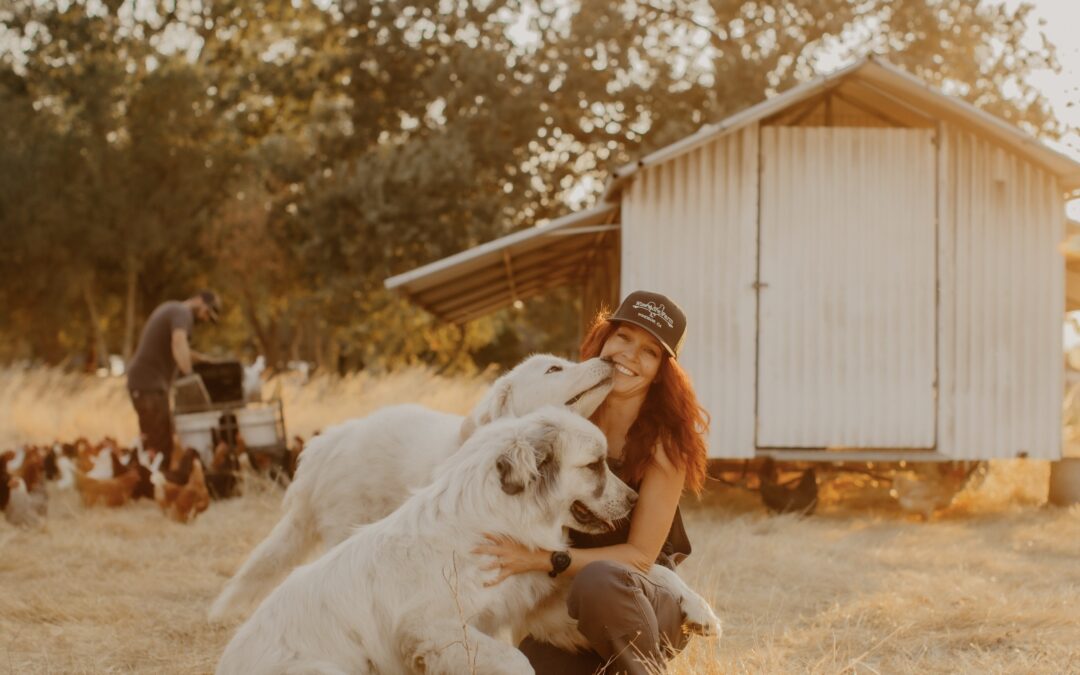Sonoma County, California is known for its famous vineyards and rolling hills. Just north of Santa Rosa lies Tiffany Holbrook’s urban 15-acre pastured egg farm. Aptly named Wise Acre Farm, Farmher Tiffany is wise beyond her years. She is a powerhouse: a wife, mother, community leader, educator, and social media influencer. She has a deep love for animals, a passion for soil health and rotational grazing, and a desire to educate others about respecting livestock throughout all phases of life.
Becoming Wise Acre Farm
While Holbrook didn’t grow up on a farm, her 30-year connection to her farm began when she was a little girl. Holbrook grew up across the street from the property she currently farms, in what she refers to as cookie-cutter suburbia. As a child, she watched through her window as the farmer across the street worked with his animals, and she loved his egg vending machine. Little did she know that one day she would grow up to tend those fields and stock that egg machine herself.
Holbrook’s family moved away from the farm across the street, but she never forgot the things she saw there. As a high schooler, she begged her dad to get chickens, and eventually wore him down. Her first ever coop was stocked with McMurray Hatchery Ameraucanas, Rhode Island Reds, and Buff Orpingtons. Holbrook’s entrepreneurial spirit was evident even back then, as she raised a new group of chicks for the people in her community each spring.
Years later, as an adult, Holbrook realized the farm she grew up watching was for sale, and the rest is history. She left her job as an elementary school secretary to start Wise Acre Farm, a complete and total leap of faith. She stepped into a full-fledged operation as a first-generation farmer, allowing her passion for learning and her love for her animals to guide her.

What is a Livestock Farmer?
“I have always wanted to work with animals. My mom kept all my childhood projects, and in every single one, I wanted to work at a zoo or be a vet. Back then, those were the options in your head when you loved animals and wanted a career working with them. It never occurred to me to be a livestock farmer,” Holbrook says. But, what is a livestock farmer in today’s society? Often, when people hear the term “farmer,” it conjures up images of large-scale commercial operations and white eggs coming from caged birds. Holbrook wants to change that narrative, to be a different kind of farmer. Her goal is to shift that mindset by allowing others to see that many farmers, like herself, work tirelessly to care for their animals.
Raising Chicks
Holbrook starts each new season with a fresh group of chicks rather than bringing in ready-to-lay pullets that were raised elsewhere. Her goal is to add about 750 new layers to her flock every year. Over time, Holbrook has developed a two-year brooding rotation, raising three groups of 275 new chicks at a time. The two-year system is crucial to her program, as that is how long hens remain in her laying flock. When a new breed of chicks enters the brooder, she knows it is time to begin phasing that breed out of her main laying flock and begin processing them for further use as spent hens.
During “Year One” of her system, she begins with Rhode Island Red chicks, as Heritage breeds are slower to mature and lay. Mid-way through the season, she brings in Pearl White Leghorns because they are laying powerhouses that require very little feed and thrive on pasture. Holbrook also views these particular hens as an opportunity to break the stigma surrounding white eggs, which are often associated with battery-cage laying operations. She uses these hens to educate customers about the quality of eggs from pastured hens, highlighting the strength and texture of the shell, and the depth in color of the yolk. For her final batch of chicks in this rotation, Holbrook raises production Red Stars (red sex links), which will help jump-start spring laying in February. During “Year Two,” she repeats the same pattern of Heritage, high-volume layers, and production breeds using Barred Plymouth Rocks, Ameraucanas, and Black Stars.
“This allows for a rainbow of egg colors because each year has a light brown, a dark brown, and a colored or white egg. I also don’t have to use leg bands to tell the ages of my hens because of this system,” Holbrook states. She also likes to incorporate a few other breeds in her flocks, such as Polish and Silkies, to add variety in egg size, and to draw customers in during her farm tours.
Holbrook also keeps White Holland turkeys, and wants this threatened breed to act as aerial predator guardians in addition to adding an educational element to farm tours about the importance of raising endangered breeds.
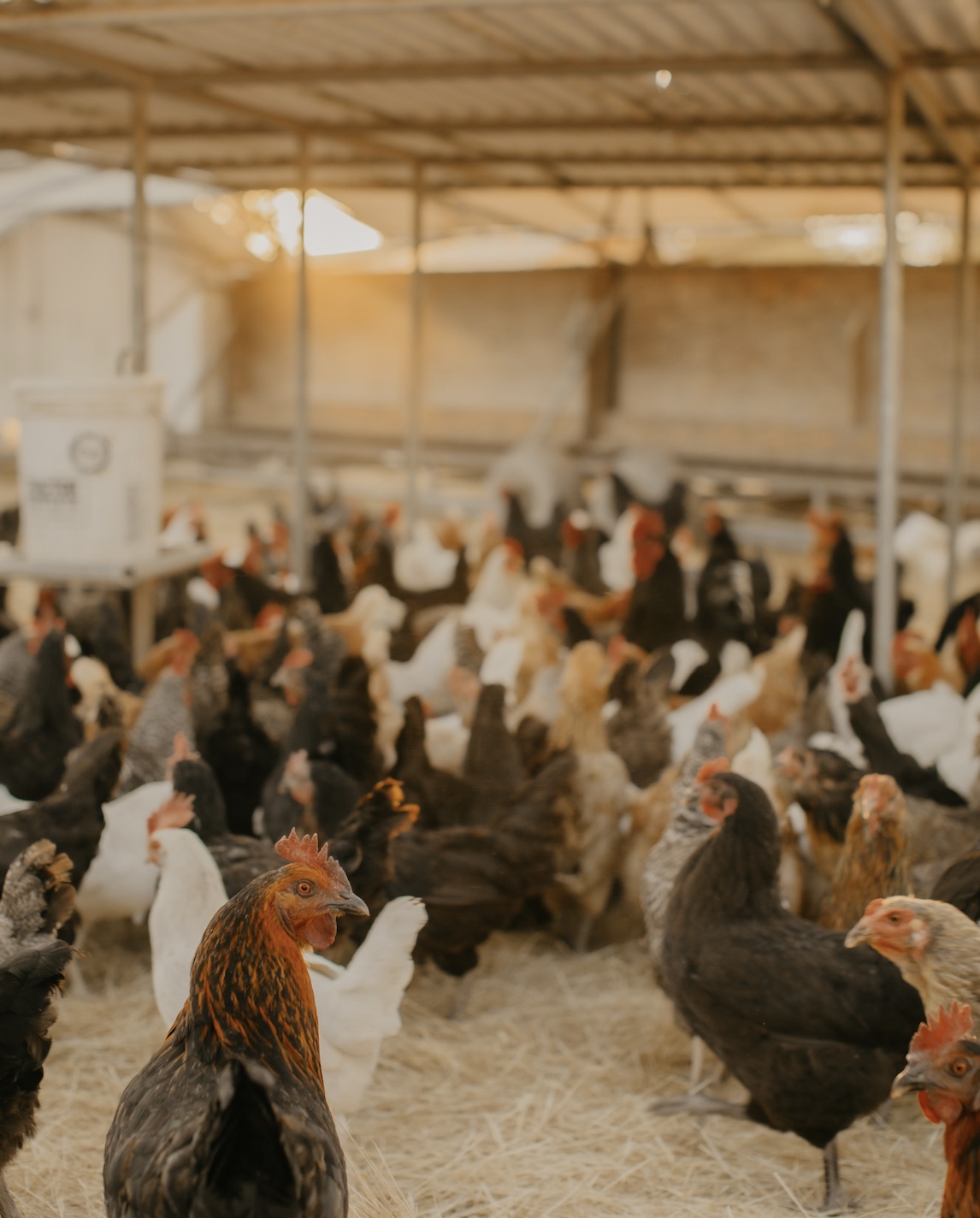
Rotational Grazing and Soil Health
Holbrook offers her hens an organic/Non-GMO feed that is made specifically for Wise Acre Farm at a local mill. Feed is fermented and given to laying flocks twice a day. Holbrook also operates a hydroponic fodder system and sprouts barley to feed to her chickens during California’s dry season, ensuring that they always have access to fresh greens.
Under Farmher Tiffany’s watchful eye, her flocks are moved throughout her 15-acre property using portable fencing. Holbrook sections off an acre each time she moves her hens, and then moves them several times within that space before repeating the process on fresh pasture. “During wet winters, the flock is moved daily. In the summer, we move about every four days,” she explains. Holbrook says that her birds are strategically ranged rather than free-ranged, as she must manage grass quality and soil health, allow time for her land to rest, and account for California’s drought conditions throughout the year.
Holbrook plants a wide variety of cover crops at Wise Acre Farm, including mustard, radish, clover, oat, rye, and barley. These cover crops add nutrients to the soil and are a useful tool in attempting to eradicate foxtail throughout the property. By rotating her laying hens on diverse pastures, they have the opportunity to feast on fresh greens, hunt for bugs, and scratch at the dirt under open skies. Within this system, an age-old cycle is honored at Wise Acre Farms: flocks reap the many benefits of ranging and grazing while returning nutrients to the land itself.
A Profitable Business
Holbrook’s employs a multi-faceted approach to selling her eggs. She has egg licensing within the state of California and urges other farmers to learn about the requirements within their respective states, as well as USDA regulations surrounding egg sales. For her regulations and requirements, Farmher Tiffany stays below 3,000 laying hens, and her egg license requires her to wash, candle, and grade eggs before selling them to the public. Holbrook gets about 950 eggs daily from her main flocks during peak season.
Farmher Tiffany has found a way to diversify her egg sales so that she is able to reach a wide variety of customers in her community. Wise Acre Farm still uses the iconic egg vending machine from way back when Holbrook was a little girl. The vending machine is stocked with farm fresh eggs by hand each day. Egg sales are self-serve, allowing customers to select their desired size and pay electronically at the vending machine. Eggs are offered in peewee, small, large, extra large, and duck. Holbrook notes that in addition to chickens, she keeps about 30 Khaki Campbell and Gold Star hens as duck eggs sell out incredibly fast. Wise Acre Farm also sells eggs to several local restaurants and provides Grade B eggs to a local bakery. “In total, we sell about 225 dozen eggs a week out of the vending machine, and over 150 dozen go to restaurants and wholesale accounts each week,” she says.
Diversification Through Community Partnerships
Pastured eggs are not the only product offered at Wise Acre Farm. Marin Coastal Bee Company keeps multiple hives on the farm property, offering truly local and raw honey for sale to the public.
Wise Acre also partners with a small, nearby ranch, providing local grass-fed beef as well. The steers rotationally graze an 18.5 acre property in Sonoma County, benefitting several endangered plant species found within their pastures. Wise Acre Farms offers the beef products for sale at their monthly open farm events.
Holbrook also partners with Kaya Bird, a pastured poultry operation run by Farmher Sarah Kolpin, another first-generation farmer with a passion for regenerative agriculture and deeply nourishing food. Kolpin raises several batches of Murray’s Big Red Broilers throughout the season and offers her pastured poultry products for sale through Wise Acre Farm. This partnership allows Holbrook to further diversify operations while still focusing on maintaining the integrity of the food she offers to the public.
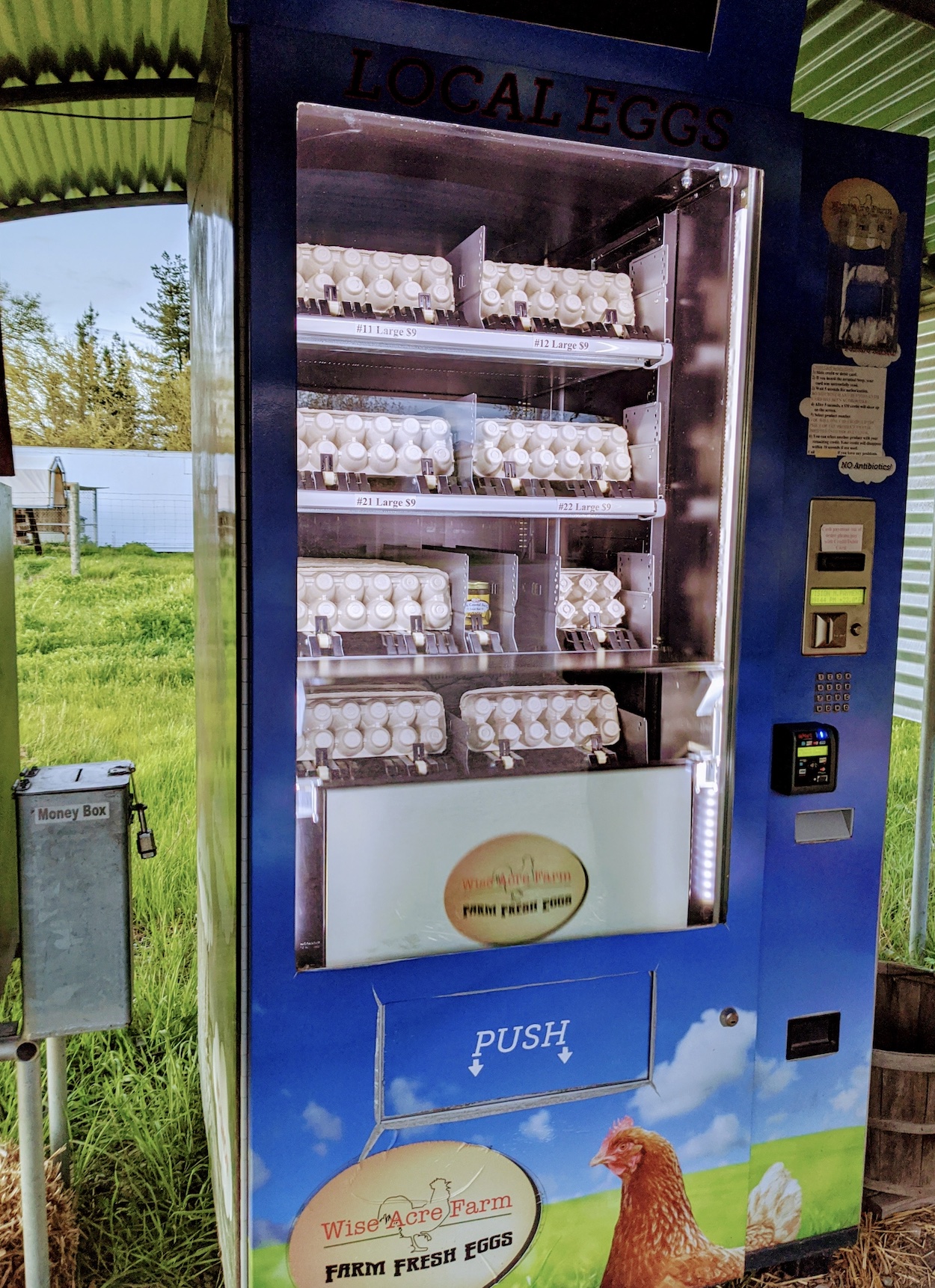
Use What You Have
Part of the egg industry that isn’t widely spoken about is what happens to hens once they phase out of their peak laying years. As a strong advocate for honoring her animals by providing them with a high quality of life, Holbrook also educates others on the value of processing spent layers and how they can provide deeply nourishing food for families. She emphasizes the importance of using what you have, offering respect for livestock throughout all phases of life, and honoring them all equally no matter their intended use.
Overcoming Challenges
Farming in California comes with its own unique set of challenges. Fire season is prevalent each year, and heat is an ever-increasing issue. This past year, temperatures soared past 116 at Wise Acre Farm. Not only are high heat, drought, and fire threats hard on livestock, but they also affect Holbrook’s ability to manage her farm, too. These extreme conditions mean she must time pasture rotation, receive chicks, and plant cover crops around the most brutal summer conditions.
Despite her farm’s summer challenges, Holbrook has managed to figure out how to mitigate damage whenever possible. “During fire season, we utilize the chickens as a form of fire prevention in our pastures, making sure that if we ever have another wildfire on the farm, there isn’t much dry grass to burn,” she explains.
Wise Acre Farm also sees its fair share of predators. Bobcats, coyotes, skunks, raccoons, and foxes are all kept at bay with movable fencing, which also allows hens access to controlled ranging. However, because she can’t electrify her fencing due to fire risks, she uses traditional Livestock Guardian dog (LGD) to help protect her birds from predators on the ground. In addition to dogs, she uses roosters, geese, and turkeys to help act as guardians against aerial predators. Holbrook keeps guardian geese in with her ducks, as they are an excellent protection against red-tail hawks.
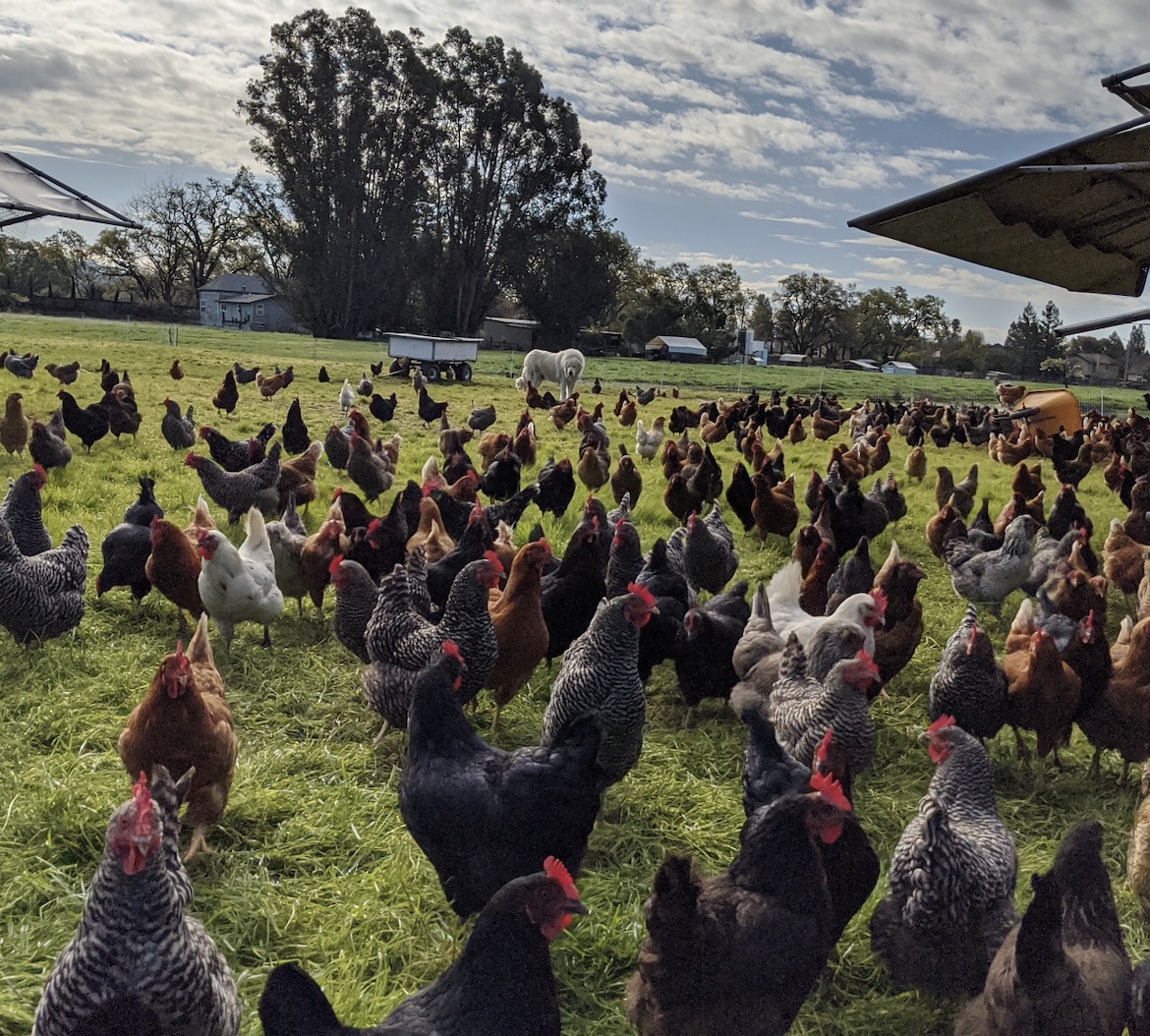
Influence and Inspiration
Farmher Jacki of Fowl Creek Farm has been an inspiration to Holbrook since the beginning of her career. When Wise Acre Farm was just starting out, there were very few people talking about raising food in a regenerative way, especially in regards to poultry.
Kirsten Lie-Nielsen from Hostile Valley Living also wrote a book about geese that was instrumental for Holbrook in shaping her flock of guardian geese. While many other farmers talk about keeping a single gander as a guardian, Holbrook saw firsthand how being alone impacted her own gander, Bobo. Bobo was a Sebstopol taken in after a fire, and he struggled being all by himself. He would leave to hang out with wild geese and cry as they flew over. With Kirsten’s guidance, she added Lucky, Woodstock, and four others to her guardian flock.
“The coolest thing about farming,” Holbrook says, “is that there are a million different methods.” Holbrook has grown into her role as a farmer over the years, drawing on wisdom from others and applying it in a way that works best for her farm and community.
Education, Social Media, and Marketing
Holbrook uses her presence on Instagram, the Wise Acre Farm website, and her visibly urban location to educate others about their food. “I love that we connect people to where their food comes from. They know what the animal looks like, and what the byproducts are,” she says.
In addition to teaching others about the value in butchering spent layers at two years of age, Holbrook also strives to market the lesser-used byproducts of processing poultry, such as feet and organs, which she is able to successfully sell to specific populations within her area. She encourages others to get to know the micro-communities in their own regions, learn about local audiences, and modify their business offerings to a variety of markets in order to increase marketability and reduce overall waste.
In addition to community education and marketing strategies, Holbrook is transparent and open with her public audience. “I’m everywhere, all the time. I volunteer in town on school boards and local chambers,” she says. Her farm is also open to the public, and is highly visible to passersby. Her strong presence within her community has helped her to increase sales via influence and connection. She also hopes to expand her educational focuses to include tips about marketing in the farming industry.
A Dream Realized
Wise Acre Farm is more than a farm. It’s a childhood dream realized, a community resource, and a hub of education. It’s 15 acres of pastured poultry, offering deeply nourishing eggs and meat to those who know the value and importance of a life well-lived. Farmher Tiffany seized the opportunity to live out her dream, continuing grow in connection with her animals and her land.
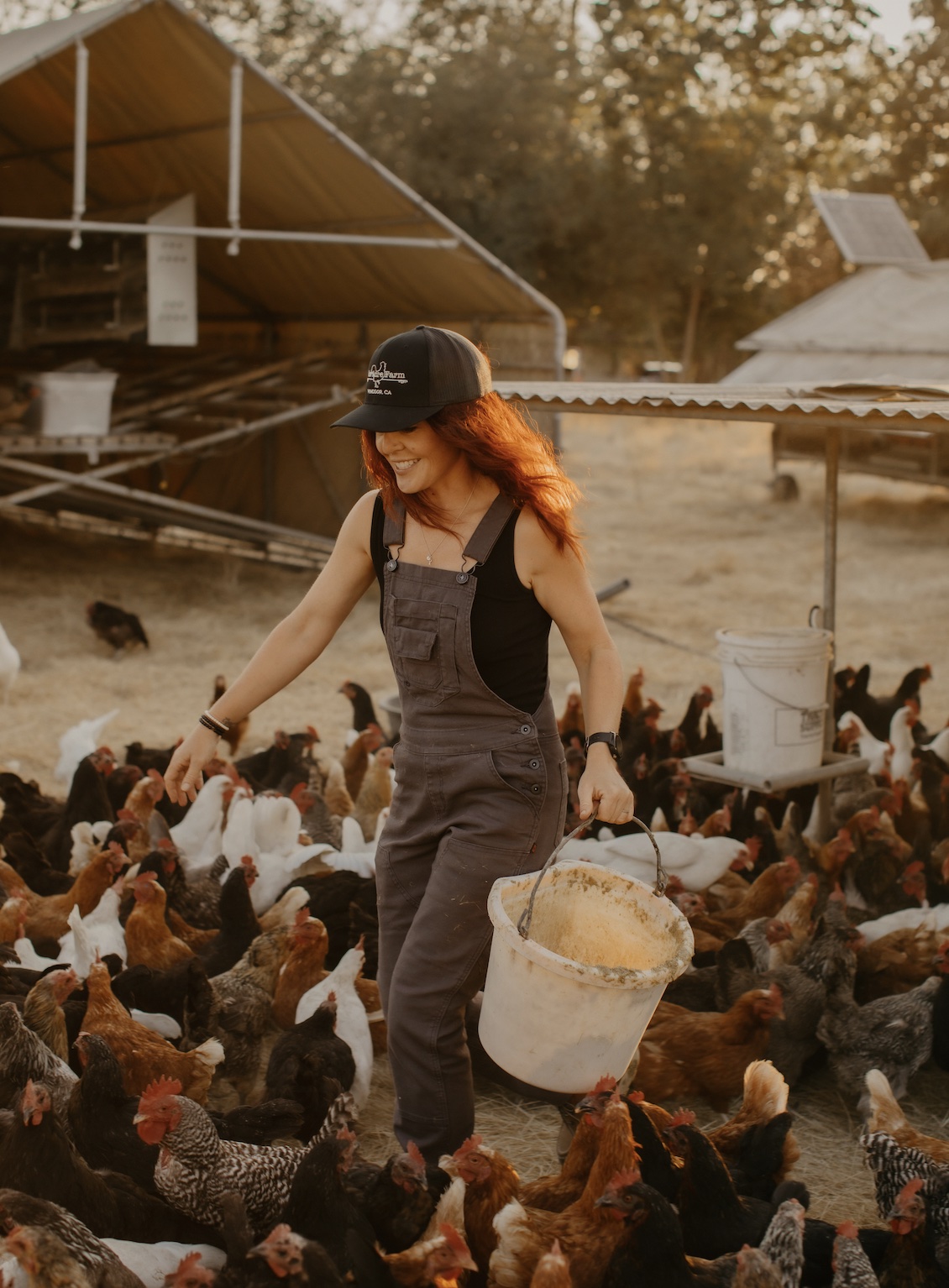
Photos courtesy of Tiffany Holbrook and Morgan Rose Photography.

